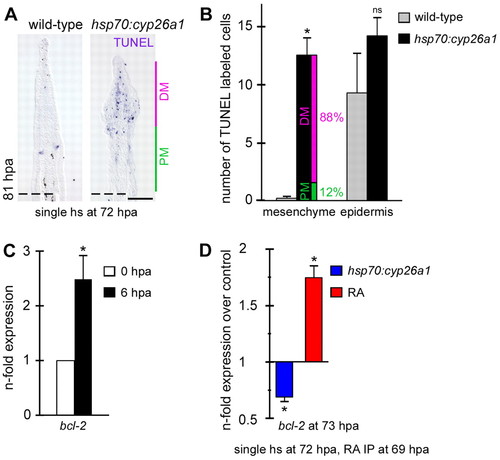Fig. 7
- ID
- ZDB-FIG-111223-15
- Publication
- Blum et al., 2012 - Retinoic acid signaling controls the formation, proliferation and survival of the blastema during adult zebrafish fin regeneration
- Other Figures
- All Figure Page
- Back to All Figure Page
|
Blastema cells possess a strong RA-mediated pro-survival mechanism. (A,B) Loss of RA signaling during regenerative outgrowth causes cell death in the regenerate after a single heat shock at 72 hpa. (A) TUNEL staining on longitudinal sections at 81 hpa reveals massive cell death in the distal mesenchyme in hsp70:cyp26a1 fish. (B) Quantification of TUNEL-labeled cells in hsp70:cyp26a1 regenerates at 81 hpa (wild type, n=35 sections; hsp70:cyp26a1, n=31). Pink and green bars in B show the ratio of labeled cells between the distal and proximal mesenchyme of hsp70:cyp26a1 fish as a percentage of the total number of labeled cells in the mesenchyme. (C) qPCR determination of bcl2 transcript levels at 6 hpa relative to uncut (0 hpa) fins. (D) bcl2 transcript levels, determined by qPCR, in heat-shocked hsp70:cyp26a1 fish (control is heat-shocked wild-type fish) and RA-treated fish (control is vehicle-treated fish) relative to control fish at 73 hpa (single heat shock at 72 hpa, single RA IP at 69 hpa). Error bars, s.e.m. *, P<0.0001 in B; *, P<0.01 in C; *, P<0.001 in D; ns, not significant. Dashed lines indicate amputation plane. DM, distal mesenchyme; PM, proximal mesenchyme; hs, heat shock. Scale bar: 100 μm. |

